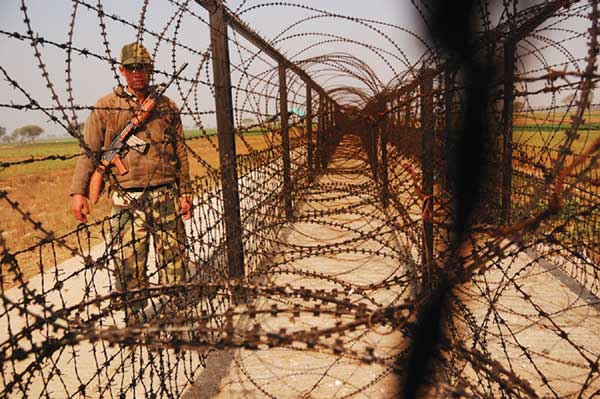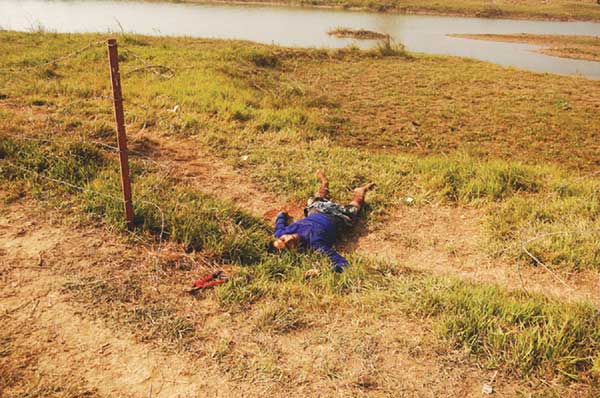Cattle Smuggling and Terrorism: Let’s come straight to the point. The cattle-smugglers of West Bengal, their knowledge of the border areas, the gaps and the vulnerable areas through which infiltration could happen, their contacts with cattle traders and truckers in the hinterland of India and their contacts with cattle merchants in Bangladesh, all of this combines to form a massive cross-country network. Can’t terrorists use this network to get in and out of the border? Yes, they can. If this perspective indeed generates a serious security scenario, then it’s important to understand Cattle Smuggling and its link to terrorism.
The Subverted Indo-Bangladesh Border : I
The Subverted Indo-Bangladesh Border : II
Few days after I reached the border areas in the Murshidabad sector in West Bengal, I was told there was intelligence about a group of cattle smugglers who planned to take hundreds of cattle across the border. One facet that is not known is that after 6 pm the deployment in the eastern frontier switches into a combat-ready mode. Every day in many sections of the border cattle smugglers attack border guards. Lonely alert soldiers manning 500 metre stretch each are vulnerable to a sudden attack in pitch darkness.
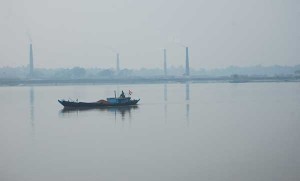 Soldiers are attacked with knives and sickles and other sharp weapons. I received information that a group of cattle smugglers has struck again, breaching an improvised fence to take cattle from India into Bangladesh. When I reached the spot, I met G. Srinivas, a BSF solider: “This place has a makeshift border fence of barbed wire and bamboo to stop people from crossing over. At 5:30 pm some cattle crossed over from here. When cattle smugglers operate there are 5-6 men to every animal. They are received by Bangladeshis on the other side. They keep in touch via mobile phones.” I asked, “How do they get the cattle across?”
Soldiers are attacked with knives and sickles and other sharp weapons. I received information that a group of cattle smugglers has struck again, breaching an improvised fence to take cattle from India into Bangladesh. When I reached the spot, I met G. Srinivas, a BSF solider: “This place has a makeshift border fence of barbed wire and bamboo to stop people from crossing over. At 5:30 pm some cattle crossed over from here. When cattle smugglers operate there are 5-6 men to every animal. They are received by Bangladeshis on the other side. They keep in touch via mobile phones.” I asked, “How do they get the cattle across?”
“They inject them with some chemical, which makes the animals restless and they start running. They do this when there is a gap in our patrols and crash through the fence so at least 5-6 of them manage to get across,” he answered. The Border Security Force estimates the volume of trade at around thirty to forty thousand crore rupees. Bangladesh’s economy of leather exports and bone china is also made from smuggled cattle regularized as ‘animals of unknown origin’ once it reaches Bangladesh.
In the final analysis the BSF soldiers show exemplary commitment in manning the border knowing fully well the operational constraints imposed by extra-constitutional political and administrative vicissitudes. The BSF has operational leeway within a 15 km band from the zero line. It has powers to detain, interrogate infiltrators and intruders to prepare a case history. But eventually it’s local police who have to register a FIR, take custody of the accused and take the case through the judicial process. This is where the entire security architecture collapses because of massive corruption in the West Bengal police. Adding to that is the political interference in policing matters. Off the record I was told of several instances where the local police allegedly set free infiltrators after BSF handed them over.
The Sundarbans, a maze of mangrove forests, river channels and river islands is very vulnerable to terrorist incursion. In fact, from the Bangladeshi side of the Sundarbans, a speed boat at 40 knots can reach the heart of Kolkata city within two and a half hours.
At several BSF camps along the border, I came across cattle seized by BSF soldiers, seized after encounters with smugglers. In fact, I closely monitored one encounter through the night listening to gun fire and wireless conversations as the BSF soldiers tried to prevent a massive cattle run. I was told that a group of 25 smugglers had set off hundreds of cows and buffaloes to crash into the improvised fence and dash to Bangladesh. Next morning I was told that a cattle smuggler had been shot dead as he tried to slash the neck of a BSF soldier with a sickle. I went to the spot. The cattle smuggler, a 20 year old youth from a village close to the border, was lying face up on a roll of barbed wire that he had managed to snipe. A cutter and a sickle were on the ground next to him. The BSF soldiers deployed on location said that some cattle smugglers had managed to rush the cattle through. In fact, this is a daily occurrence in this part of the border in West Bengal. Everyday cattle smugglers attack these forward points to push in cattle by dismantling the temporary fence towards Bangladesh, which is hardly 200 yards from the fence.
Preventing cattle smuggling in the ‘char-land’ area, a riverine border region in Nadia district in West Bengal is a challenging task for the BSF. These vast tracts of land along the Ganga, made dry when the river changed its course, are where hundreds of cattle smugglers operate, illegally transporting livestock from India into Bangladesh. Tackling cattle smuggling in the ‘char-land’ during the monsoon when the river is in full spate is extremely risky. Cattle smugglers take advantage of this and push the cattle into the river allowing the natural current to take it to Bangladesh. “It’s very dangerous. It becomes very difficult to stay in control. There are 4-6 people in our boats whereas if a boat has 50 animals, it also has at least 100 smugglers. They sometimes attack us as well and we are forced to open fire,” said Raghavin Prasad Mishra, BSF, Platoon Commander at the Lawangola post.
In some parts of the char-land the borderlanders have set up villages, like the 60 square kilometre char-land called ‘Nirmal-Char’. Most border villagers are subsistence farmers and so they take to cattle smuggling to supplement their income. I spot a farmer on the charland and catch up with him. His cattle are clearly exhausted from a long journey, but Saifuddin Sheikh, like most border villagers, denies that there is any smuggling in the area.
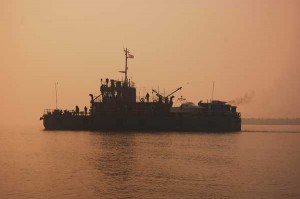 “A: Earlier people used to cross over from both sides openly.
“A: Earlier people used to cross over from both sides openly.
Q: But there are reports of infiltration from Bangladesh especially at night?
A: No, that is not the case. It’s not easy anymore.
Q: Do you know cattle smuggling is done from here?
A: No, it does not happen anymore.
We have to submit our photo ID. We have to submit a photo ID of our cattle also before going,” said Mushtaqin. The borderlanders share a tense relationship with the BSF. “People probably crossover from Lalgola region (Murshidabad sector), but it is we here who suffer. We have to submit our photo ID at the BSF post before proceeding to the char-land. We can only do this between 6 am and 11 am, after which entry is not allowed into the char-land,” said Marjina Bibi.
The BSF says that if cattle can be smuggled so easily, nothing prevents prevent terror groups from using the porous border. “Cattle smuggling is a problem, (it) is a challenge. Lakhs of cattle do come, they come from hinterlands, these are the problems we will be bringing to the notice of government and we have brought to the notice of the government. It is no crime, no offence to bring cattle from lets say Rajasthan or Madhya Pradesh. Only when it reaches the border and from the border as you know, there are a number of ways (of crossing over),” said Kumawat, BSF DG. With the eastern border becoming an infiltration zone for Pakistan and Bangladesh based terrorists, cattle smuggling could soon be used a cover by more dangerous criminals.
The Vulnerable Sunderbans
Petrapole in Barasat in West Bengal is one the state’s three integrated check points with Bangladesh. It’s also the busiest, with 400 trucks and over a thousand people crossing this point every day. India and Bangladesh do business worth 3.6 billion dollars ever year. And there is an additional 2.7 billion dollars in illegal trade. A newly-revived train service has increased contact between the two countries. Hilli in South Dinajpur is another integrated checkpoint high on people to people contact and trade.
As I stepped out of his house I discovered that I had actually stepped out of Bangladesh and when I entered the cattle shed adjacent to his house I realized was in India. I had just experienced what it was like living in a house through which an international border went through!
Despite a heavy border security presence, however, this land port is routinely exploited by illegal infiltrators and militants. Government regulations stipulate that the customs are the only authorized agency to deal with trade. So the Border Security Force is not authorized to check any of the trucks or consignments coming into, or leaving India, a rule that’s crippling security at this checkpoint. Ashok Banerjee, district magistrate, Balurghat categorically confirmed that the final authority when it came to trade matters, even if its security related, was the customs.
But on the spot assessment revealed the truth; all the customs authorities do is give a cursory glance lifting tarpaulins and peeking at the goods. Nobody knows for sure what lies beneath. Trucks can bring in contraband, arms and ammunition from Bangladesh through this ICP. The BSF and the intelligence agencies say customs authorities don’t check the goods thoroughly enough. As many as 740 licenses have been issued for trade along this point, increasing the chances of smuggling and infiltration. Customs authorities insist that the checkpoint has a problem. “The number (of licenses issued) needs to be verified. But this is indeed a problem. There are many licenses. We have to check for smuggling,” said Banerjee.
The loopholes in West Bengal’s border security extend beyond land as well. The Sundarbans, a maze of mangrove forests, river channels and river islands is very vulnerable to terrorist incursion. In fact, from the Bangladeshi side of the Sundarbans, a speed boat at 40 knots can reach the heart of Kolkata city within two and a half hours. India shares 70 kms of its riverine border with Bangladesh in this region, which runs through the middle of the Ichamati River. I travelled along this riverine border on a BSF speedboat. With Bangladesh and India separated by a river the only deterrence for the terrorists was the BSF speedboat patrols and vigil maintained on BSF posts on the Indian side of the river bank. Except for the presence of the BSF, coastal security in the Sundarbans is almost non-existent. The West Bengal police are yet to set up coastal police stations or recruit, train and equip the coastal police. The West Bengal government has sanctioned five coastal police stations in the Sunderbans region. But till those police stations come up this entire area is open to infiltrators from the sea.
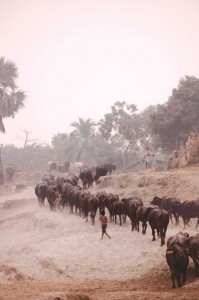 On a map the border is a straight line, but on the ground things aren’t so simple. The border winds through both land and water here, making it difficult to tell whether one is in India or Bangladesh. I visited the ‘First Main Pillar’ which marks the beginning of the land border. Here I walked along narrow strip of land which was Indian Territory. On one side was the Ichamati River and across the river, too, was Indian Territory. But the moment I moved leftwards away from the narrow strip on the river bank I was technically walking into Bangladeshi territory. So complex is the border geography that it makes border management an enormously challenging task.
On a map the border is a straight line, but on the ground things aren’t so simple. The border winds through both land and water here, making it difficult to tell whether one is in India or Bangladesh. I visited the ‘First Main Pillar’ which marks the beginning of the land border. Here I walked along narrow strip of land which was Indian Territory. On one side was the Ichamati River and across the river, too, was Indian Territory. But the moment I moved leftwards away from the narrow strip on the river bank I was technically walking into Bangladeshi territory. So complex is the border geography that it makes border management an enormously challenging task.
The border-dwellers are caught between a border they feel has been imposed on them. I visited a village in this region where the zero line runs right through its middle, dividing families and neighborhoods. At Rabibur Rehman’s house I experienced the confusion that prevails in the border areas. As I stepped out of his house I discovered that I had actually stepped out of Bangladesh and when I entered the cattle shed adjacent to his house I realized was in India. I had just experienced what it was like living in a house through which an international border went through! This kind of unique boundary is not seen anywhere in the world.
The uniqueness of the India-Bangladesh border was further reaffirmed when I reached one of the two floating border observation posts maintained by the BSF. Anchored near the mouth of the Ichamati estuary, around 20 soldiers work here, patrolling the border. “The usual schedule is 15 days but if some other B.O.P. is under maintenance or anything it maybe further extended,” said Hetram of the BSF Marine Wing. Across the riverine border which stretches almost 70 kms along the India Bangladesh border, the BSF use such floating B.O.Ps to monitor movement along the riverine border.
The BSF knows that terrorist infiltration through the sea is a clear and present danger. The riverine border areas along the Sundarbans are difficult to patrol. Inspector Vikash, a Company Commander informed me that “after 26/11 we received information that the next infiltration might be in this Sunderbans region. This is vast and riverine region and we are guarding our border up to the estuary point and for such a large area a good and effective border domination plan is required. The possibility cannot be ruled out but we are doing our duty and have effectively dominated the border.”
Conclusion
Villages in No Man’s Land
In the Nadia sector I travelled to Indian villages beyond the border fence. A combination of riverine and land terrain has created unusual situations along the India-Bangladesh border. The complexity of the geography of this place blurs the traditional concept of sovereignty and makes it difficult to manage the border only through the lens of security. At the Hatkhola village in West Bengal’s Nadia district, many Indian citizens are effectively stranded in no-man’s land because it lies beyond border fence. The village lies right on the edge of the border, with the zero line running through the middle of a water canal. According to a 1974 bilateral treaty, India cannot build defensive works within 150 metres of the frontier. The border fence has cut off thousands of Indians from the rest of India. At 6 am every morning, villagers from Hatkhola have to show their ID cards to pass through the border gates into their own country.
At one such border gate I watched Ziad Ali Sheikh, resident of Hatkhola Gram, pass through the gate after his credentials and ID card was checked by the BSF border guards.
…eventually its local police who have to register a FIR, take custody of the accused and take the case through the judicial process. This is where the entire security architecture collapses because of massive corruption in the West Bengal police.
“Q: You cross over everyday using the card. Who gave you this card?
A: This card has been issued by the Hatkhola Gram Panchayet.
Q: This jacket can be bought anywhere. It’s available on the open market you could have bought it from anywhere?
A: No we have to show our voter ID card to the panchayet, then only this photo is attached and the card given to us.”
Ziad Ali Sheikh uses an ID card issued by the local panchayat. The card jacket, bearing the Ashoka Chakra, can be bought from a local market for 15 rupees. Villagers in Hathkola admit that Bangladeshis who are willing to pay can easily buy Indian ration cards or voter cards. “The people do not understand. That’s why they can cross over to work here or they help people to cross over in exchange of money. The people need to understand the adverse effect of crossing over and steps should be taken,” said another resident of Hatkhola, Anup Kumar Dhar.
Soon after our conversation ended, I saw Ziad walking from the border gate towards the nearest village market, some 10 kilometers away. He turned back and told me “I have to get back within the next 12 hours.” Thousands of Indian citizens – Hindus and Muslims – leave India and return to their homes beyond the border fence every day. The zigzag India-Bangladesh border has led to many anomalies along its route. The checks seem foolproof, yet there are ways to beat the system. “The problem is that in the present scenario if you consider the manpower of BSF here you would be able to understand that infiltrating and smuggling goods, even arms, RDX, etc are also possible and easy,” said Ashadul, another Hatkhola villager.
A report in the The Hindu newspaper quoted Saheb Ali Sardar, a Hatkhola panchayat member as follows: “The administration and political parties turn a blind eye to it because objecting would result in losing votes. The elections are coming and we need the vote of the people. We cannot jeopardize our party’s chances of winning by tipping off the authorities about the smugglers. That would risk angering those engaged in such illegal activities.”
The threat is clear and evident. Across India’s border with Bangladesh, a gateway of terror lies exposed. These glaring gaps in security could one day be exploited by groups bent on wreaking terror, unless action is taken soon.




